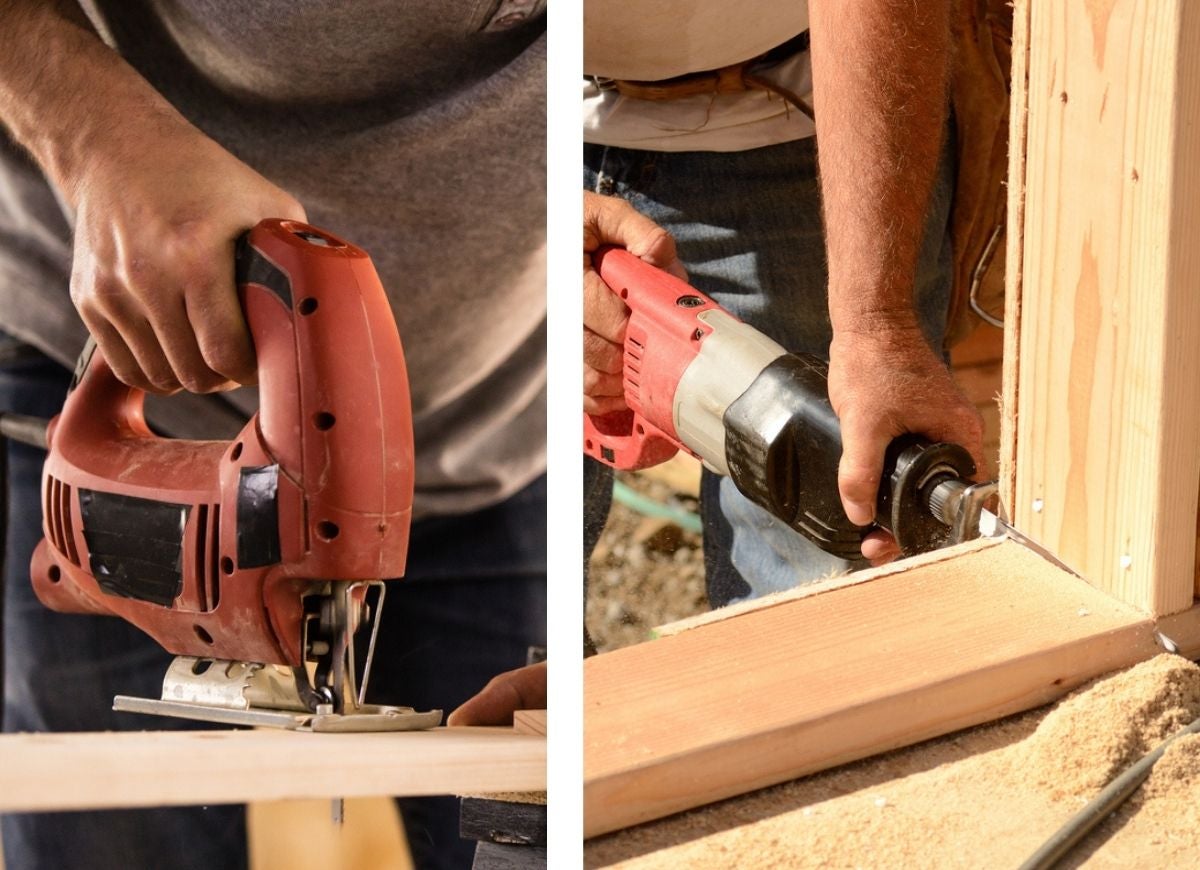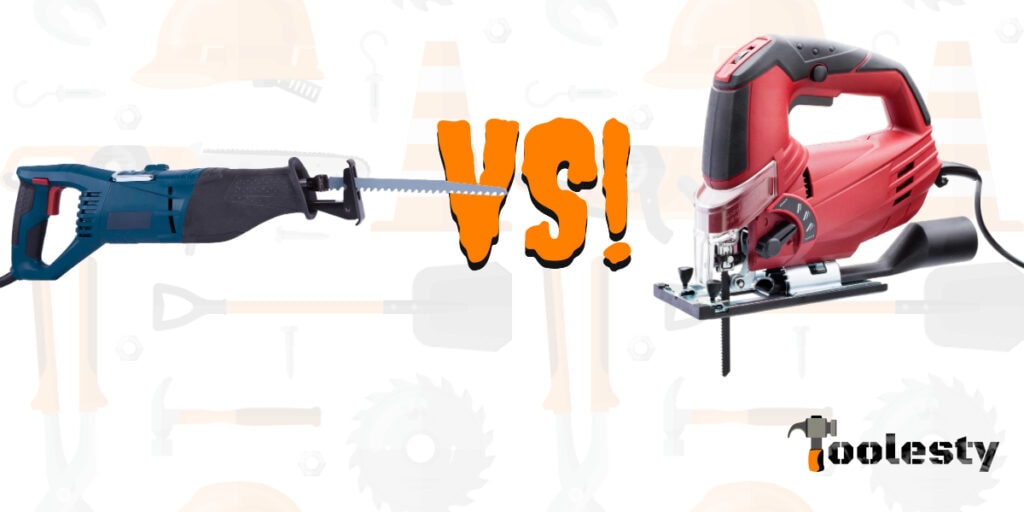Have you ever wondered if you can use a reciprocating saw as a jigsaw? Well, you’re in the right place to find out! 🤔 In this article, we’ll explore whether or not these two power tools can be interchanged, and what you need to know before attempting it. So, let’s dive in and unravel the mystery!
When it comes to DIY projects and woodworking, having the right tool for the job is essential. 👷 But what happens when you only have a reciprocating saw and a project that calls for a jigsaw? Can you make do with what you have? That’s exactly what we’re going to explore here. So, let’s get ready to uncover the truth behind using a reciprocating saw as a jigsaw!
Before we unveil the answer, let’s take a moment to understand what each tool is designed for and how they differ. Reciprocating saws are great for demolition work and cutting through a wide range of materials, while jigsaws are specifically designed for intricate cuts and curves in wood and other materials. With that in mind, let’s dive deeper and find out if these power tools can be used interchangeably. Curious? Let’s find out together!
While a reciprocating saw and a jigsaw are both power tools used for cutting, they have different features and purposes. A reciprocating saw is designed for rough cutting tasks, such as demolition and cutting through thick materials. On the other hand, a jigsaw is more versatile, allowing for precise and intricate cuts, making it ideal for woodworking and detailed projects. So, while you may be able to use a reciprocating saw as a makeshift jigsaw in certain situations, it’s not recommended for precision work.

Can You Use a Reciprocating Saw as a Jigsaw?
Reciprocating saws and jigsaws are both powerful cutting tools commonly used in woodworking and construction projects. While they have some similarities, they serve different purposes and are designed for specific types of cuts. Many people wonder if they can use a reciprocating saw as a jigsaw or vice versa, especially if they only have one of these tools on hand. In this article, we will explore the differences between reciprocating saws and jigsaws, their capabilities, and whether or not it is possible to use one in place of the other.
The Difference Between Reciprocating Saws and Jigsaws
Reciprocating saws, also known as “Sawzalls” (a popular brand name), feature a straight blade that moves back and forth rapidly to cut through various materials. They are typically used for rough cuts, demolition work, and tasks that require aggressive cutting action. On the other hand, jigsaws have a smaller, fine-toothed blade that moves up and down rapidly. They are designed for more precise and intricate cuts, making them ideal for curved or intricate shapes.
Reciprocating saws have a longer stroke length, allowing them to cut through thicker materials and perform tasks such as pruning trees or cutting through pipes. Jigsaws, on the other hand, have a shorter stroke length and are better suited for making plunge cuts, bevel cuts, and intricate shapes in wood, plastic, or metal.
These key differences in blade type, stroke length, and cutting action make reciprocating saws and jigsaws tailored for different applications. While both tools can cut through various materials, their designs and capabilities are optimized for specific cutting tasks.
Can You Use a Reciprocating Saw as a Jigsaw?
While it is technically possible to use a reciprocating saw as a jigsaw, it is not recommended or ideal. The straight blade of a reciprocating saw is not designed for the precise and intricate cuts that a jigsaw excels at. Using a reciprocating saw for fine cuts may result in rough edges, splintering, and lack of control.
However, in situations where a jigsaw is not available, and you need to make a rough cut or perform a task that does not require precision, a reciprocating saw can be used as a temporary alternative. Just keep in mind that the results may not be as clean or detailed as they would be with a jigsaw.
If you frequently encounter projects that require precise and detailed cuts, investing in a jigsaw would be a wise decision. It will save you time, enhance your woodworking capabilities, and ensure cleaner and more accurate cuts.
Key Takeaways: Can You Use a Reciprocating Saw as a Jigsaw?
– While a reciprocating saw and a jigsaw have similar cutting actions, they are designed for different purposes.
– A reciprocating saw is primarily used for demolition tasks like cutting through pipes, nails, or branches.
– A jigsaw, on the other hand, is specifically designed for intricate woodworking tasks and making more precise cuts.
– While it is possible to use a reciprocating saw as a makeshift jigsaw for simple cuts, it may not provide the same level of accuracy and control.
– It is always best to use the appropriate tool for the task at hand to achieve the best results and ensure safety.
Frequently Asked Questions
Are you wondering if you can use a reciprocating saw as a jigsaw? Look no further! We’ve got the answers to your burning questions right here.
1. What is the main difference between a reciprocating saw and a jigsaw?
A reciprocating saw and a jigsaw may seem similar, but they have some key differences. A reciprocating saw is designed for rough cuts and demolition work. It has a long, straight blade that moves back and forth rapidly with a push and pull motion. A jigsaw, on the other hand, is used for finer, precision cuts. It has a shorter, thinner blade that moves up and down in a smooth, controlled manner.
So, while both tools can cut through various materials, a reciprocating saw is better suited for aggressive, heavy-duty tasks, while a jigsaw excels at detailed, intricate work.
2. Can a reciprocating saw be used in place of a jigsaw for precise cuts?
While a reciprocating saw can cut different materials, it is not the best tool for precise cuts. The aggressive back and forth motion of a reciprocating saw blade can make it challenging to achieve the accuracy you need for fine woodworking or detailed cuts. Additionally, a reciprocating saw blade tends to produce rougher edges compared to a jigsaw blade.
If you require precise cuts or want smoother edges, it’s recommended to use a jigsaw specifically designed for those tasks. A jigsaw provides more control, precision, and a smoother cutting action, making it the go-to tool for intricate work.
3. Are there any situations where a reciprocating saw can be used as a jigsaw?
While a reciprocating saw is not ideal for precise cuts, there are some situations where it can act as a makeshift jigsaw. If you need to make rough, straight cuts in materials like lumber or sheet metal and don’t have a jigsaw on hand, a reciprocating saw can be used as a temporary solution. However, keep in mind that the results may not be as precise or refined.
For small DIY projects or quick fixes, using a reciprocating saw in a pinch can be helpful. Just be sure to take extra caution and practice with scrap materials before attempting a critical or intricate task.
4. Can you use jigsaw blades in a reciprocating saw?
No, you should not use jigsaw blades in a reciprocating saw. The two tools have different blade mechanisms and are not interchangeable. Jigsaw blades are designed for the up and down motion of a jigsaw, whereas reciprocating saw blades move back and forth. Trying to insert a jigsaw blade into a reciprocating saw can result in blade breakage or damage to the tool.
It’s essential to use the correct blades for each tool to ensure optimal performance, accuracy, and safety. Always consult the manufacturer’s recommendations and guidelines before using any tool.
5. Are there any other tools that can substitute a jigsaw?
There are a few other tools that can serve as alternatives to a jigsaw, depending on the specific task at hand. For example, a circular saw with a guide can be used for straight cuts, while a coping saw is great for intricate curves. Additionally, a scroll saw is ideal for detailed, delicate cuts in thin materials like wood or plastic.
It’s important to choose the right tool for your project to achieve the best results. Each tool has its own unique features and capabilities, so consider the task, material, and desired outcome when selecting a substitute for a jigsaw.

Summary
You might be wondering if you can use a reciprocating saw as a jigsaw. Well, the answer is yes! Both tools have similar cutting motions, but they each have their own strengths and weaknesses. A reciprocating saw is great for heavy-duty tasks, like cutting through thick materials. On the other hand, a jigsaw is better for precise and intricate cuts. So, while you can use a reciprocating saw as a jigsaw in a pinch, it’s not the best choice for detailed work.
It’s important to remember that using a tool for a purpose it’s not designed for can have its limitations. So, if you find yourself needing to make accurate cuts or work on delicate projects, investing in a dedicated jigsaw would be the way to go. But if you just need to rough cut some materials, then using a reciprocating saw as a jigsaw can be a temporary solution. Always prioritize safety and choose the right tool for the job.
